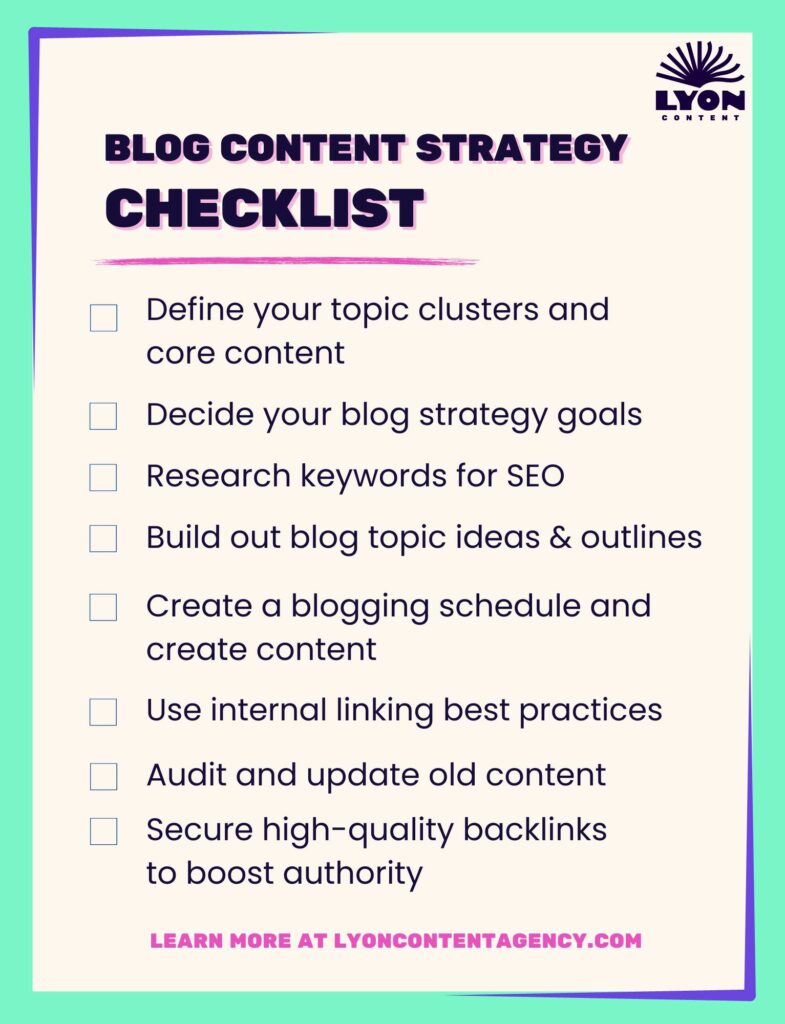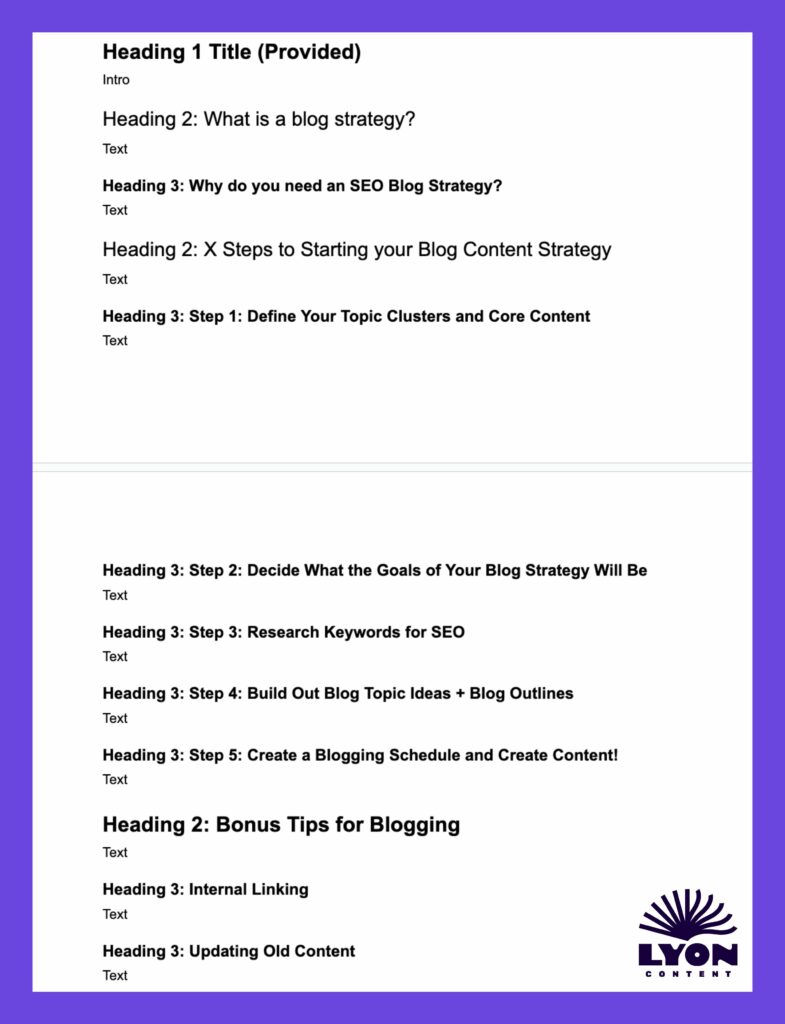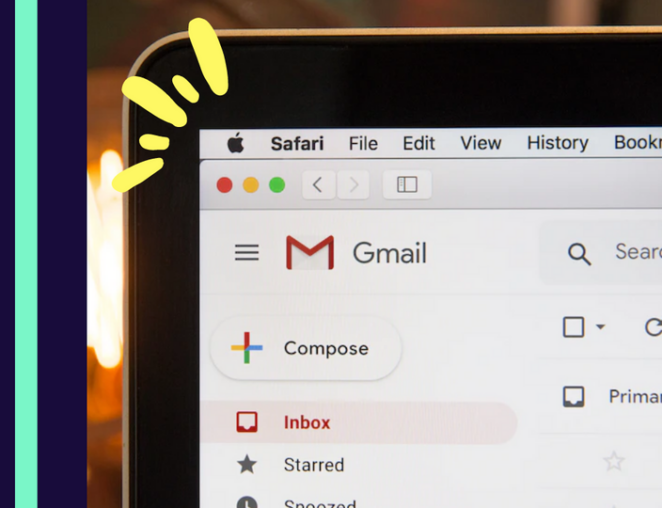What you’ll learn
In today’s media loving landscape, do blogs really spark interest anymore? Short answer: Heck yes. Long answer? Brands that blog see a whopping 97% more backlinks to their site, and 53% of marketers prioritize blog strategy as a leading content marketing tactic.
Why? Because blog posts generate traffic and revenue.
Publishing blog content means you’re actively educating both new and existing audiences, and capturing their interest before your competitors do is essential to build trust during the first stage of the sales funnel: awareness.
At this point, your prospects are wide and furthest from a sale. But if you learn how to start a successful blog strategy that prioritizes their needs, solves their biggest problems, and entertains them along the way?
🪄The results flood in.
Ready to build a bulletproof blog strategy that engages them from the jump?
Together with expert tips from our SEO partner Kim Fischer, who has helped countless clients dominate the SERPs with bulletproof content strategies, we’ll break down every step in this guide.
So walk with me, talk with me, and let’s watch that needle move.

What is a Blog Strategy?
A blog strategy is a roadmap informed by audience insights and SEO that helps you attract potential new customers to your website and achieve biz goals.
Whether that’s to build brand awareness and establish yourself as a thought leader, boost conversions, or grow your blog traffic exponentially, this all starts with knowing exactly what to publish.
When we build an SEO blog strategy for our clients, we begin by deeply understanding their audience’s needs. We also look at their competitors’ to see what content they’re posting and if we can find any content gaps.
We use this preliminary research to build a successful blogging strategy inclusive of:
- Customer personas
- Content strategy
- Blogging KPIs
- Topic clusters
Why do we focus on all this research before actually writing any content? Because data should be at the forefront of every blog strategy. Otherwise, you’re playing the guessing game, and what does Kim have to say about that?
“Publishing something is better than nothing (as long as it’s relevant). However, when you do this, you’re risking wasting a lot of valuable time and resources. You could be targeting keywords with no searches or keywords with too high a difficulty to rank for.”
Let’s learn how to start a successful blog with a strategy that generates results and shines Google’s ever-loving light on your content.
8 Steps to Creating Your Blog Content Strategy
Like anything in the world of digital marketing, it’s easy to over-complicate a blog strategy. But we’re here to remove the guesswork and give you the most direct route toward blogging brilliance.
Here’s your blog content strategy roadmap at a glance:
- Define your topic clusters and core content
- Decide your blog strategy goals
- Research keywords for SEO
- Build out blog topic ideas & outlines
- Create a blogging schedule and create content
- Use internal linking best practices
- Audit and update old content
- Secure high-quality backlinks to boost authority

Step 1: Define Your Topic Clusters and Core Content
For many brands, coming up with topics is as difficult as determining who really deserved to sit on the iron throne. I mean, it’s obvi to us, but the discourse is real…
But choosing blog topics isn’t rooted in your opinion, it’s influenced by your audience’s opinions, which you can grab from looking at the keywords they type into Google.
Once you have that info? Kim says topic clusters should indicate:
- What the brand offers
- What its competitors are doing
- How big or how much of their resources are going to go into a blogging strategy”
Kim advises that not every offer will make a good topic cluster, especially if they don’t have high search volume, profits, or relevance. Instead? It’s essential to look at competitors who are actually ranking on the SERPs.
“How are they splitting up their content? What are they writing about? Can your team write effectively within 15+ different topic clusters? This would mean consistently writing about most of these clusters every month. Take a look at big marketing companies like HubSpot. They write multiple articles a day. Most businesses don’t have the resources.”
If you’re a small biz, start with 2-4 topic clusters. Kim says you can always break them up and expand as you grow.
Let’s take an example from an alternative hair solutions client. They can answer basic FAQs about their products and use those as topic clusters:
Topic clusters example:
- Alternative hair basics: Answer the who, what, when, why, and where
- Alternative hair styling & maintenance tips: Provide expert tips for your target clients to make the most of their new hair products
- Alternative hair news & trends
Starting with those three clusters will unlock a ton of topic ideas, but be sure to do your keyword research first to see which ones you can actually rank for.

Notice something interesting about the results we achieved for our client? These top-ranking articles all target long-tail keywords in their topic clusters. Instead of just targeting “human hair wigs” which is extremely competitive, we targeted “most realistic human hair wigs.”
Long-tail keywords often reflect searchers further down the funnel, meaning they may be closer to conversion – right where you want to catch them.
Step 2: Set Realistic Blog Strategy Goals
Now that you have a topic list in hand, think about your business blog’s goals. Your key performance indicators (KPIs) convey the reason why you’re building this blog strategy.
What is the purpose and function of your blog? To build brand awareness and generate more high-quality leads? Great! Those are two fabulous metrics to guide your blog strategy and content creation.
Without clear goals, your blog will look directionless, and that is the last thing we want for your biz. If you create clear KPIs, you can then set in place small, actionable benchmarks to help you achieve those goals.
And according to Kim, that all starts with getting your Google analytics and Google Search console set up properly, and measuring things like:
- Organic traffic directly on blogs
- Conversions from Organic Search
- Impressions on the search console
- Clicks on the search console
So if you take on that first goal of getting more organic traffic directly to your blog posts, you might set up milestones like:
→ Conduct keyword research to find relevant topics
→ Create high-quality content that genuinely helps your ideal audience
→ Publish one post per week
→ Index blog posts on Google to ensure they’re visible
→ Track and monitor performance to see which posts are trending topics
→ Refine strategy to produce more relevant content
But keep in mind that these will absolutely evolve as your business grows.
“Assuming you have an omnichannel marketing strategy, you’ll notice that people will be finding your blogs far beyond just organic search. That’s the beauty of blogging; You can repurpose and link back to that content in your email marketing and your social media!”
We love an omnichannel marketing strategy, which is why we help our clients repurpose their blog posts into various written content formats, including social media content, newsletters, videos, landing pages, and more!

Step 3: Research Keywords for SEO
Ah, keyword research, the elusive SEO tactic that seems reserved for big box brands… or is it?
Not a chance. Ranking for the right keywords isn’t some secret sauce, but it requires you to dig beyond basic terms.
“It’s better to collect a ton of lower volume keywords with a low keyword difficulty than try and rank for mainly very high volume keywords with a very high keyword difficulty,” says Kim.
A great way to find low difficulty keywords?
“Niche down your content; Think about your blogging strategy as answering FAQs. They’re not googling “beauty supplies” when they want to know “What are the best hair products for 4C hair?”. More niche, long-tail keywords, are going to your best friend when you’re in a highly competitive industry/location.”
And as Kim advises, it’s vital to go for this low-hanging fruit, especially in competitive industries.
Use tools like SEMRush, Ubersuggest, or Google Keyword Planner to conduct keyword research, toggling the search features by competitiveness and difficulty.
Another great idea? Hop on Google Trends to see which topics are trending in your industry. If you’re on the AI bandwagon, you can also experiment with AI software like ChatGPT or Jasper.AI, and use a comprehensive prompt to ask it for industry topics and ideas.
Just be wary about using it for anything beyond that. AI is a great tool for brainstorming, but the creative genius lies in human thinking. 🧠
Topic clusters? Done. Keyword research? In the bag. Next up? Laying the framework for kickass blog posts.
Step 4: Build Blog Topic Ideas + Blog Outlines
Now comes the fun part: creating your blog outlines. This is like putting together a digital puzzle, plucking keywords and long-tail search phrases into headings. But remember: every blog post should lead with value by educating the reader first before trying to squeeze in keywords.
My team and I like to write the content first, then find the most natural placements for the keywords (outside of the headings and meta descriptions, of course, because those usually flow harmoniously).
Pro tip? Long-tail keywords make great headings and FAQs.
Here’s an example of a blog outline that I used to write this article:

Think of your blog outline as the bare bones of the content, keeping you relevant and safe from venturing off into abstract territory.
Then, tackle each section one at a time. I treat each section as an independent article within itself, ensuring it has a strong hook, meaty body content, bullet points or quotes to break up the copy, and a smooth-as-butter transition sentence to lead into the next section.
However, I recognize that outlining blog topics and knowing exactly what to write can feel like pulling teeth.
Read up on what the top-ranking articles are covering. What core info do they include? This can inspire your research, just be sure to convey it in an authentic and unique way. Look for areas to add value and differentiate your content.
This will get the creative juices flowing and see what ground you must cover in a fresh, authentic way.
And don’t forget about holiday and seasonal articles, like Black Friday marketing, shopping, or buying guides relevant to your audience.
If you need a helping hand, peep our SEO blog strategy services here.
Ok, so considering all these hot irons in the fire, it’s an absolute must to roll out an editorial content calendar.

Step 5: Create a Blogging Schedule and Create Content
Now’s the time to sit down and create a realistic blogging schedule. As busy entrepreneurs and marketers, we often have a zillion ideas floating around.
Many of our clients have wanted to come out the gates roaring and publish a blog post every day to kickstart results. And I get it: who wants to wait 6-12 months for SEO to gain traction?
But managing a blog calendar eats up significant firing power. There’s keyword research, content strategy, writing, editing, optimizing, publishing, refining…the list goes on.
Considering all of that leg work, how much time do you realistically have every week for blogging?
If you’re DIYing it, start with one blog a week. If you hire a blog writer or blogging agency, you might be able to bump that up to 2-3 posts a week.
Point is: set a blogging schedule you can stick to, because Google and pretty much all search engines love consistency and quality.
Google favors E-E-A-T content (experience, expertise, authoritativeness, and trustworthiness). If you’re hammering out content just to go live without strict quality control checkpoints, or relying entirely on AI to generate your content, you’re not going to see positive results.
Kim adds that quality content also has to do with answering the question quickly and efficiently.
“You don’t want your readers not getting the full answer, heading back to the SERP, to find someone else with a better answer. You also don’t want your readers getting bored or confused halfway through reading that they do the same thing; head back to the SERP to find someone else with a better, more clear answer.”
Be concise, yet comprehensive. Take as long as it takes to thoroughly answer the question with rushing or rambling.
“You are writing (or hiring someone to write) for real people, who really want their questions answered. You can put all the right keywords, and have all the technical SEO optimization, the best branding, and UX, but if the content isn’t high quality, none of that matters. Remember, Google isn’t buying what you’re selling, REAL people are,” says Kim.

Bonus Tips for Blogging
Follow all the steps above and you’ll have a bulletproof blog strategy rooted in research and ready to generate results. Want to take the edge over your competition? Here’s how to go the extra mile:
6. Use Internal Linking Best Practices
If you have a new website that’s not retrofitted with a rich content bank yet, you’re going to mainly link internally to your core web pages (about, services, contact, home). But as you publish more content you can internally link to related blog posts.
Internal linking ensures that your visitors click onto other pages within your website, rather than bouncing and seeking that info elsewhere. Keep a spreadsheet of all your blog posts and topic clusters, and connect the digital dots.
Pro tip: Don’t forget to revisit previously published content and add links to your new posts, too.
7. Update and Re-Optimize Old Content
Trends change, buying patterns shift, and marketers must keep up with the ever-changing tides. The content you published last year doesn’t hold the same weight today.
So? Audit and update your existing content:
- Add linked statistics or sources with new research
- Check the SERPs for top-ranking content on the same subject, and look for content gaps to beef up your existing content.
- Add new internal links
- Update any broken links or images
- See if there are any new keywords you can add to the content
Pro tip: Re-optimize old content every 3-6 months, or as needed depending on how often you publish.
8. Score High-Quality Backlinks
New websites lack something called Domain Authority. It’s a metric search engines use to gauge how authoritative (and therefore rank-worthy) your website is. Since the domain is new, you naturally start at the back of the pack.
Gain speed by getting backlinks pointing to your site from higher-authority websites.
There are a few ways to do this:
- Publish kickass content that commands authority, and you’ll start to naturally get links, but this can take some time to build up the digital street cred.
- Reach out to publications, podcasts, public figures, and industry websites and see if they will feature you on their site. This can take the shape of guest posts, interviews, Q&As, or features in roundup posts.
- Publish press releases about industry news and buzz that might get picked up by larger websites.

Why Do You Need An SEO Blog Strategy?
Here’s the deal: every piece of content you publish should benefit your target audience. With a laser-sharp blog strategy, you’ll ensure you publish strategic content that your readers actually give a damn about.
Sharing juicy insights and actionable tips for your audience helps Google view you as an authority. As a reward for your dedication, it’ll start to rank you higher on the search engine results pages (SERPs).
“When you have a blogging strategy, not only do you have a keyword strategy in place, but you’re also creating content that is reaching a goal for your brand. You’re meeting people where they’re at in terms of what they’re reaching for, and where they’re at in the customer journey.”
From there, you’ll start to receive backlinks from quality websites, which will boost your Domain Authority and reaffirm with search engines that you know your sh*t.
But this all requires time and finesse. No one launches a successful blog strategy overnight. It takes research, high-quality content, diligence, patience, constant monitoring and performance tracking, fine-tuning, and above all: consistency.
This rings especially true in the era of AI, which doesn’t really benefit a brand’s target audience, according to Kim.
“In a time where AI is accessible to everyone, what’s going to make people stand out is their brand voice and ability to understand their Ideal Client Avatar (ICA), which is a snapshot of your ideal customer’s behavior, speech, and purchase behavior.”
You can absolutely DIY an SEO blog strategy, or you can outsource to trusted blog writing services.
In fact, 62% of B2B marketers outsource blog copywriting and strategy, so if you’re tempted to do so, you’re certainly not alone.
Best news? As blog writing and content strategy pros slaying the game for nearly a decade, we’ve got the goods you need to succeed in the digital space.

Ready to Become a Blogging Badass?
Are you still with me? As large an undertaking as creating a blog strategy seems, our goal is to demystify the process and set you up with actionable tips to make it attainable.
And remember: you don’t have to launch a mega blog from the get-go. Progress takes time. Set realistic goals, use data to inform your strategy, and get to know your audience in real-time by engaging with them on socials.
The more you know about your audience, the better you’ll be at publishing content that reaches and engages them.
Follow this blog strategy roadmap and you’ll be on your way to generating serious results for your business.
And if at any point you need a helping hand? Call on our blog writing services. We’re waiting in the wings to join you on stage.

09/18/2023
Christina Lyon is the founder and CEO of Lyon Content. She’s fired up for helping brands kickass online and grow their digital empires. Christina lives in So Cal with her husband and two dogs, and nerds out on reading, traveling, writing creative fiction, and getting lost in wild places. She’s obsessed with a good underdog story and eats more rice bowls than she’s willing to admit.




